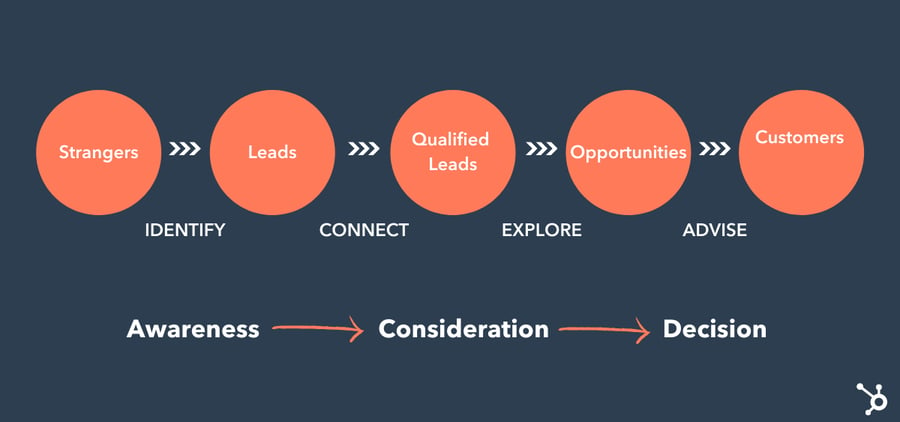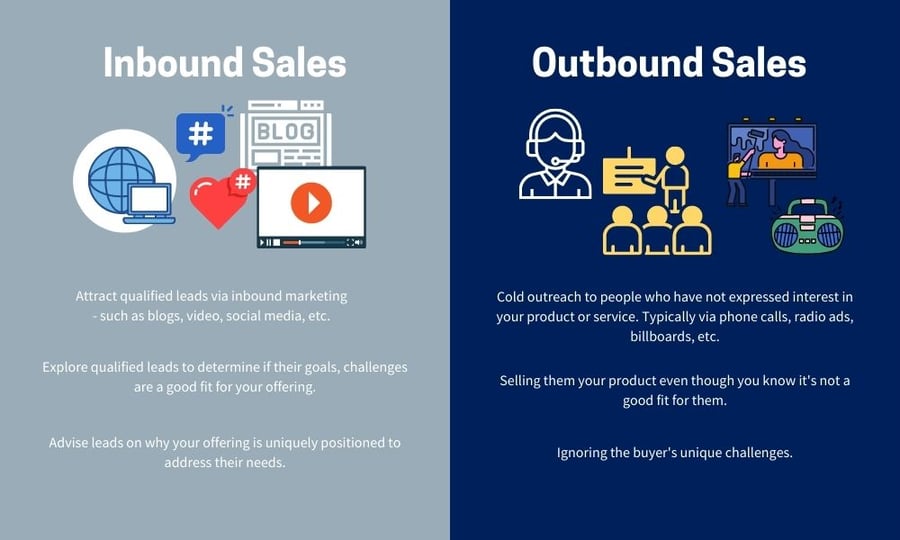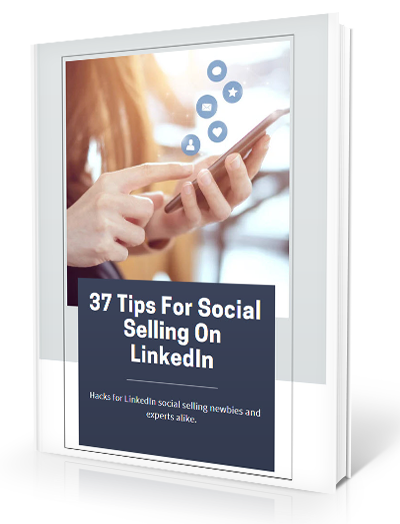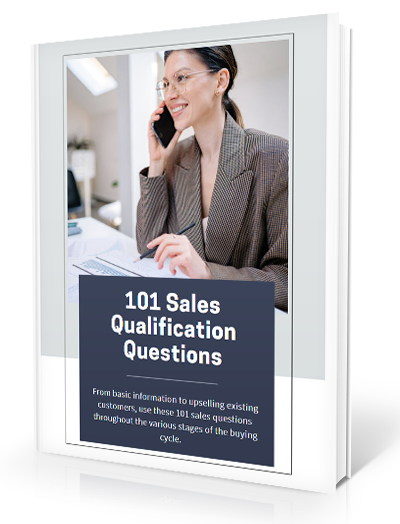Sales Strategy
What does it take to create a winning sales strategy? Strong market research? An understanding of your target market? A SWOT analysis?
If that were the secret sauce, many businesses would find themselves generating a lot more revenue.
What you need is a clear plan. It doesn't have to be complicated. But it should be well thought out. By creating a plan, you develop a competitive advantage over others that don't have one and miss the boat.
Below, we'll look at how to develop a solid process and action plan that takes you out of the status quo and into long-term repeat business and a strong position for sustainable growth.
What Is A Sales Strategy
 What Is A Sales Strategy?
What Is A Sales Strategy?
A sales strategy is a well-researched, written plan for how you'll position your product or service in the market and sell it to your target customers. A successful sales strategy guides your sales team on how you'll set yourself apart from your competitors to make your brand, product, or service seem the better choice among prospective customers.
To accomplish this, you need to know who those prospective customers are. What matters to one person may not matter to another, so know whom you're speaking with. You must also have a clear understanding of the competition. Who are their target customers? How are they attracting and engaging them? What message are they communicating?
Of course, this marketing message begins in an organization's marketing strategy and continues seamlessly into the sales strategy, so marketing-sales alignment matters.
Your researched and written sales strategy includes several key components:
- SMART Goals - Specific, Measurable, Attainable, Relevant, Timeframe-specific
- Growth Goals - Goals for developing sales team agility and scalability
- Sales Process - A pre-established set of steps, sales pitches, and resources used to make the sale
- Key Performance Indicators (KPI) - What do you need to track in order to know you're on track toward meeting goals?
- Team Structure - How many people do you need, who do you need, and how will you organize them to work effectively?
- Technology - How will you use technology to automate tedious processes, streamline the sales process, and maximize the productivity of sales reps?
- Buyer Personas - Who are your target customers? What are their common traits, goals, challenges, and objections that your team needs to know so they can navigate them to make the sale?
- Selling Methodologies - How do you relate to customers? Outbound Vs Inbound Sales may come into play here.
Any sales strategy template should address each of these aspects of sales planning.
Whether you're developing a sales strategy for the first time or it's time to revamp your underperforming sales department, know that these days the power is in the buyer's hands. Today, more than ever, they can avoid your ads, leave if you get "salesy", and choose to do business with brands that align with their values.
These customers also have the power to propel your brand. When your sales strategy approaches the buyer with a resonating message, they can increase your brand's magnetism for ideal customers, lower your customer acquisition costs, increase sales, and maximize profitability. These 5 Sales Strategy Tips for Successful Selling can help you develop that kind of plan.
Types Of Sales Strategies
What does a successful sales strategy look like? There is no one answer. No cookie-cutter sales strategies will work for all companies. But in most cases, an effective sales strategy will be a combination of these.
 Sales Strategies
Sales Strategies
- Social selling
- Becoming a thought leader
- Prioritizing inbound sales calls
- Researching and qualifying prospects
- Cold calling
- Offering a demonstration
- Providing a clear and precise end result
- Adapting your offering
- Nurturing existing accounts for future selling
Social Selling
It involves doing the following through your social media channels:
- Social listening, by researching how your customers use social media, what they talk about, and how they engage with brands on social media.
- Interacting with prospects and customers on social media, such as liking and sharing prospects' posts, commenting, messaging, etc.
- Building trust, authority, and engagement on social media.
Social selling isn't about the hard sell. It's about nurturing relationships with people who've shown they're very likely to become customers -- or they already are.
Now, clearly, there's a Difference Between Sales and Marketing when it comes to social media. Typically, sales reps interact with customers and prospects who are further along in the journey, so this is time well spent. On the other hand, marketing uses social media to attract new potential customers. They sell the brand or its many offerings, while sales often sell an individual product to a specific person in a nurturing way.
Becoming A Thought Leader
As far as Lead Generation Strategies go, becoming a thought leader is hard to beat. You're sharing tips, valuable insights, and often data that the average person may not have access to otherwise. This is the best way to make a lasting impression with possible customers.
Let's be honest. No one wants to feel like they were sold to. But as a thought leader, you're seen as someone providing an expert opinion that helps people make their own decisions.
Prioritizing Inbound Sales Calls
Timing is everything in sales. If someone actively seeks information and wants to talk to sales, drop everything. This person jumps to the front of the line. Don't let this hot lead off the hook because you think they'll still be there if you keep them waiting.
Researching And Qualifying Prospects
Don't target the wrong people. Your reps will be wasting their time. If their compensation is commission-based, the good ones won't stick around in this environment. Your sales strategy should include researching a prospect before outreach.
A little browsing of social media and past interactions logged in the Customer Relationship Management tool (CRM) can guide the conversation and personalize the message in a way that helps the sales rep connect more quickly.
Cold Calling Is Still Part Of The Job
Cold calling is still part of the job. There is no getting around it. Cold calling can be effectual and it's called for in most business strategies. It can complement an inbound sales strategy. With that said, some techniques work better than others on phone calls.
And like sports, practice builds confidence and "muscle memory", so they can pivot on a call rather than fall flat at the first objection. Have them practice their sales pitch. Get them comfortable with the sales script.
Offering A Demonstration
It doesn't matter how long they've been aware of your brand; many products require a demonstration. Now, on the marketing side of things, video demonstrations of how a product or service works are invaluable. On the sales side, the demonstration becomes personalized. Reps can go in-depth about the features that this specific person showed the most interest in.
A well-conducted demonstration tells a story. It shows (rather than just telling) how this product benefits this person.
Providing A Clear And Precise End Result
People don't buy things because they want a thing. This includes B2C and B2B alike. They have a goal. They want to feel some way about their purchase. Without these motivators, the desire to buy doesn't exist. This type of sales plan doesn't focus so much on what the product is but rather on how it meets these needs.
Adapting Your Offering
Whenever possible, empower your sales force to adapt the offering to the client's needs and current situation. A great sales strategy is precise but also flexible enough to give the sales rep a whole toolkit of tactics, resources, and offerings to mix and match to make the sale.
Nurturing Existing Accounts For Future Upselling
The buyer's journey doesn't end when you make a sale. These are more than words. Different strategies should include how you'll nurture after the sale. Great sales strategies are a partnership among marketing, sales, customer service, and the customer.
When these entities are working together to ensure that the customer is delighted (even if something goes wrong), you generate a loyal, high lifetime value customer. As such, they'll likely go to bat for your company if someone says something bad about you.
Inbound Vs Outbound Sales Methodology
Outbound is the traditional approach of casting a broad net out to as many as possible, then trying to hard sell to as many as you can. It's that just get out there and start knocking on doors approach. But you can do outbound on social media, Google, email, text, and more, so it's not necessarily a pre-digital era concept.
While this method can generate sales, it also annoys many who aren't a good fit in the process. It causes a lot of consumers to erect brick walls to "protect" themselves from unscrupulous sales tactics.
Being an outbound sales rep is one of the hardest jobs on the planet. They face constant rejection, if not hostility. If someone can't cut it in outbound sales, it's not the sales rep's fault. In industries where buying something takes consideration, and there is no one-size-fits-all solution, in our humble opinion, outbound isn't a recipe for sustainable growth.
Inbound Sales Methodology

Conversely, the Inbound methodology more closely meets ideal customers where they are in the buyer's journey. The goal of an inbound sales rep is to get the right person to move forward in the buyer's journey - to take that next step and to generate a win-win.
Inbound sales continue what started in the marketing departments that should also be taking this different approach to attract the right audience and nurture them through those early stages so that sales tactics have the best chance to close the deal.
When you're comparing, Outbound vs Inbound Sales, inbound sales are better aligned with the power today's clients have to lead their own journey - or leave at will.

Building A Sales Strategy
It is important not to establish goals in a vacuum. Get input from stakeholders to ensure your goals are indeed SMART.
Stakeholders in this situation might include sales reps, marketing management, the CEO, and the customer support supervisor. None of these alone can set reasonable goals for YOUR team. But they will provide you with varying perspectives that lead to the right goals for your sales organization.
Don't Just Rely On Your Buyer Persona
A target audience is a great place to start. You must know whom you're speaking with to connect. But as data-driven as your buyer personas may be, they're still straw people trying to stand in for real ones.
It's not just about your ideal customer profile with demographic info or attributes.
Yes, people have goals and pain points. They carefully consider your value proposition and gravitate toward solutions for their problems.
But when it comes to that moment they hit that buy now button, it's not 100% logic driving that click. People buy based on "Emotions." Their internal emotions are affected by many outside influences that will push them to make a purchase decision.
Sales departments that over-rely on personas, fail to miss the complexity of these emotions. But during customer conversations, sales reps can work to identify the real individual drivers to make the sale.
But again, we're talking about selling to someone whom the sales rep knows is a good fit and every indication is that this is the right time. The buyer is simply experiencing hesitation. Great sales reps can close deals in these moments that leave both the rep and the customer feeling happy.
Hire The Right People And Compensate Them Well
It should go without saying, compensation is not the place to cut expenses. People who feel undervalued will not feel invested in building customer relationships. They'll do the bare minimum to get by until something better comes along. Attract and keep top talent by showing you value them.
Create A Plan To Generate Demand
A solid sales strategy brings the customer base to you through web pages, social media, search engines, a downloadable e-book, networking with influential people and sites, and paid search/social.
You will get the best results when you address the unique needs of your target persona across channels. Get out there and increase awareness of your products.
Align Sales And Marketing
Clearly, there is a Difference Between Sales and Marketing. Too often, these differences become points of contention. "Marketing can't send us qualified leads". "Sales can't close the deal with qualified leads we're sending them".
Sound familiar?
But aligned, unified marketing teams create the messaging and get it out there. They work to generate leads and nurture them to the point that both sales and marketing agree they're qualified. Sales takes the baton and use the messaging marketing developed to close the deal, turning leads into new customers.
An aligned team works together to create and communicate the message. They share goals and see themselves as one team with different business roles. And honestly, a majority of buyers can tell the difference.
Measure Performance On A Individual And Team Level
When you have a good sales strategy in place, you can consistently and fairly track performance using KPIs, performance reviews, and transparent sales dashboards that allow each rep to always know where they stand. In this portion of your documented plan, outline the specific metrics you'll use to evaluate performance.
Track And Measure Your Analytics
At the same time, you need a plan to track and measure the effectiveness of your strategy and its execution. This will allow you to evaluate both and know when something needs to change. This ensures you don't "punish" sales reps for underperformance when the system is not working. That leads us to the training section of your strategy.
Training Your Sales Team
Sales training encompasses the skills, methodology, technology training, effective sales enablement resource utilization, and expectations you must impart to each sales rep to promote their success.
Pre-onboard Sales Reps
Companies that "pre-board" sales reps provide resources or training before their official first day. This way, they don't come into their work feeling like a fish out of water. They already know your methodology, basic processes and expectations on which they can build as onboarding begins.
Pre-boarding doesn't have to be extensive. It's just an overview that has the rep starting on the right foot. Make it as concise as possible (maybe 10 minutes).
Featured Article: 5 Tips On How To Convert More Leads Into Sales
Flexible Training Formats
Flexible formats allow the rep to guide their own learning to some extent to focus on what they need to work on and when they have time. These may include a combination of eLearning, videos, classroom, on-the-job, mentoring, and VR simulations, among other methods.
Personalized Training Paths
When going into a new job, the bitter truth is that you don't know what you don't know. So the hiring manager can say, "let me know if you have questions" all day long. But the new hire doesn't know what to ask.
Alternatively, you could start at the very beginning and try to teach everything a sales rep needs to know, but then your trainees tune out. They miss important information because you're having them review so much they already know.
Featured Guide:
A better approach is to evaluate the gaps in their skillset continually, so you can develop personalized training paths for sales reps throughout their time with you. As they begin working, use their performance data to identify areas they need more training and make that training available.
Leverage Peer Learning
Peer learning should not be your only form of training. But it can be a valuable tool. You can certainly put new reps with top performers, but we'd suggest a more scalable approach.
Sit down with your veteran high-performers regularly. Learn what's working for them. This information can become resource material for training manuals.
If you decide to create a competitive environment in your sales department, as many do, then veterans may not want to share the secret sauce. In these cases, practice off-boarding when people leave the team (on good terms). Learn what you can from them and then incorporate it into training.
Record Practice Sessions
People learn by doing immediately. But in a classroom, there isn't much time for applying what they learn and getting feedback. Have reps complete practice sessions, review them, and provide feedback.
Put Reps In Their Buyers Shoes
Have reps work together in mock sales sessions. One rep is the prospective customer who can voice the common objections they hear from customers. Then swap. This is a great way to help both reps see themselves from the other side and enhance their skills at the same time.
Ongoing Training And Reinforcement
Ongoing training should become a part of every rep's process. There's always something people can learn to do better.
Training gives you the opportunity to reinforce the sales activities and culture you want to see from your reps. At the same time, you can identify activities that don't align with your culture or strategy and correct them.
Sales Strategy Examples
Hubspot
HubSpot is a SaaS company that focuses on helping business owners develop, implement, and optimize inbound strategies through analytics and automation technology. They have over 56,500 customers across 100 countries and generate over $510 million in annual revenue. They have named 3 sales strategies as key to their success.
Hire the right people according to repeatable evaluation criteria.
They created a list of attributes they wanted in a sales rep like coachability, passion, and adaptability to change. From this list, they created a repeatable system to evaluate candidates.
Train the sales team by making them wear the customers’ shoes.
After documenting the sales process, value proposition, and customer targeting that would lead to success, they developed an immersive training system that mimicked the sales process. But instead of having the rep complete the experience as a rep, they walked through it as a potential customer.
Align sales and marketing.
They call their unified team the "Smarketing" team. In it, marketing works to understand what sales needs from them before hand-off. They also know how many leads they must hand off to sales each month to meet sales goals. Sales then times their contact and attempts based on data-supported best practices to generate the highest lead to sales ratio possible.
So marketing delivers better leads, making the sales reps' job easier. Sales close a higher percentage, meaning marketing needs to send fewer leads to generate the same revenue. Now, their job is easier too. When teams are aligned, everyone's job is easier and together they're more effective. Win-Win-Won!
Shopify
Shopify is an eCommerce platform that carries the prestigious designation of having generated its first $1 billion faster than any other SaaS. Here's how they get things done.
Hire great people, not necessarily great salespeople.
Similar to HubSpot, Shopify is more interested in a prospective hire's traits than their skills. They look for work ethic, creativity, entrepreneurship, and competitiveness, as well as successful work history. But they don't expect to hire superstars. They'd rather hire "great people".
Treat sales as a science, not an art.
Modern advancements in analytics mean we can not only collect but also process and use astounding amounts of data. Shopify tracks everything and continually optimizes the sales pipeline, order sizes, close rates, sales cycles, etc.
Build a smart, technological foundation.
They understand the importance of Sales automation tools to successful sales teams. When they discovered sales reps were manually logging calls and emails into the CRM, amounting to 5 extra hours of work per person per week, they weren't having it. They migrated to a better CRM.
Maintain a high-quality pipeline by eliminating unqualified leads.
Based on data, they have a 4/5 lead scoring system that allows the team to focus on prospects who are most likely to close. That means they need to meet 4 out of 5 criteria for outreach:
- Pain - They are currently dealing with a struggle and know they've got to make a change.
- Power - The lead is the decision-maker.
- Money - They have a budget to afford Shopify solutions.
- Process - Their buying process is aligned with the solutions offered.
- Timeline - They are at the right spot in the buyer's journey to warrant the time investment of a sales rep.
Salesforce
Salesforce was a tiny startup that dared to go up against the likes of Microsoft and Oracle and won. In doing so, they changed the way businesses relate to customers.
Extensive sales training
With a name like Salesforce, they knew they had to lead by example. So they've invested heavily in training their sales team continuously to reinforce best practices and constantly improve sales performance.
Focus on continuous improvement
They didn't only focus on the reps. They recognized that rep success is primarily a product of the systems in which reps work. They practice the act of continuously making minor improvements. They're always looking at how they can make something easier, faster, or better for their team. They listen actively to their people and live this mindset.
Long-Term Sustainable Sales Growth Requires A Plan
A sales plan is more than a simple statement about your target market or value proposition. It's a detailed strategy focused on the human side of selling and buying. Buyers today have the power and a voice. We can harness that power to propel our brands by creating a strategy that respects customers and the buying process. It values sales reps, data, team alignment, and ongoing growth.
If you're still feeling uneasy about creating an effective sales strategy, an inbound agency can help.
Jump To Section:








